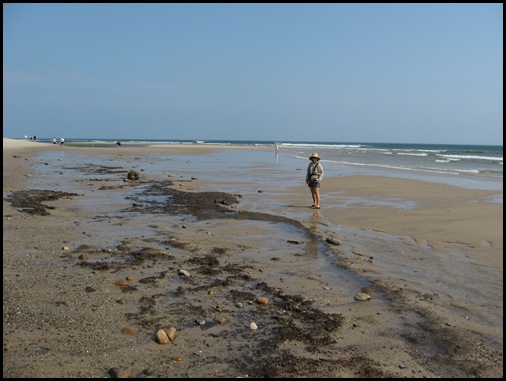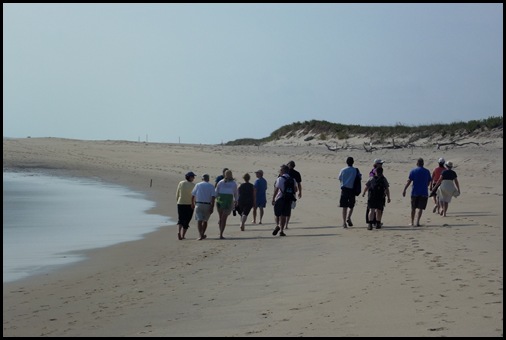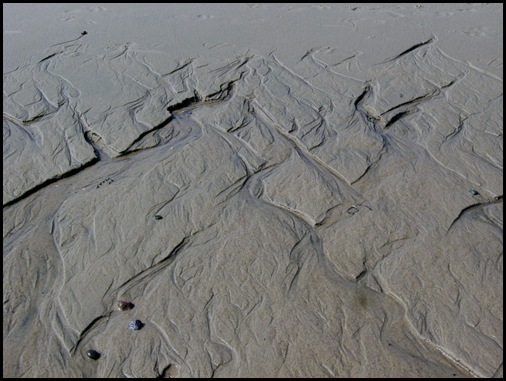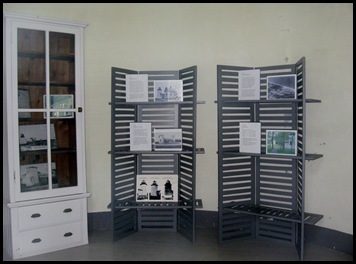Thursday September 12, 2013
Cape Cod National Seashore
Massachusetts
One of our favorite things to do in our National Parks is ranger programs.
We never go to a National Park or in this case National Seashore without doing a ranger program. The rangers know so much and are so interesting so even though we’ve seen quite a few seals over on Campobello Island, there is a 9:30 am ranger led Seal tour this morning at Coast Guard beach and we are going to go along. We arrive 15 minutes early to make sure we can get parking. We’ve been told it is limited.
Well that’s an understatement. There are possibly 50 to 60 spots with almost half of them reserved either as handicapped spots or for the education programs in the Coast Guard building. The other 25 to 30 are all taken. When I get out on the beach I see that the surf is up and most of the spots are taken by early morning surfers.
I think we are the first people of an eventual 20 people who show up. David goes off to find parking since there is no indication of where the overflow lot is. The program has started by the time he arrives back. He’s had to park over a mile away. We resolve to write a comment card about the wisdom of scheduling a program in an area guaranteed to have parking problems. The ranger waits and moves along very slowly to allow people to get back from the unexpected far away parking.
While I wait to find out exactly where the ranger will be gathering folks, I walk down to the beach.
It is broad and wide. The sand dunes are gorgeous and covered with sea oats. It is so nice to see beaches being cared for( ie left alone to take care of themselves).
At the edge of the dunes is what the ranger later tells us is peat remaining from ancient forest decay. It is one of the reasons the dune plants grow so well. It has been recently uncovered by the storms battering the coast.
The wind has picked up. The sea oats are waving back and forth. Another thing very rare along the east coast is the kind of healthy thick stands of sea oats that are here in the National Seashore. They are beautiful. I remember them from my time living by the beach in my 20’s but haven’t seen them looking like this in years of beach going since.
All attendees accounted for we begin our hike down the beach.
Our ranger tells us a lot about the seals we will see. Gray Seals here not Harbor Seals. She also is certain we will see them. The group last week at the spot we are headed to saw a group of at least 75. I am very excited.
As we walk along she becomes more and more concerned. She doesn’t see them. She’s seen them the last few times she’s done this program. But today it’s a fairly low tide and seals like high tide I think to myself.
We do see this fellow hurrying along. I think it’s a curlew. Our ranger doesn’t know what it is. Can you help me Judy?
Further along we spot one or two seals in the water but too far away for pictures.
We never spot the numbers the ranger was hoping for before our time is up. She says we can walk on down the way further if we like and perhaps we’ll see more. I’m happy for what we saw and learned about the seals. Many turn back to their cars. David and I do walk on down the beach.
We find a small group of 4 or 5 seals playing in the water and stay a long time to watch them especially the one that just sticks his snout straight up in the air. Somehow that strikes me as very funny. I’ve never seen one do that before. He does it over and over again.
Just being on the beach is just a delight. As we walk back, we see more of the exposed peat, as well as beautiful stones, bright green seaweed, and the patterns the water makes in the sand. The ocean shore is a extremely beautiful environment.

I’m reluctant to leave the beach so before we do I decide to give yesterday’s boo boos another salt water treatment.
Just a short way up the coast is the Nauset Beach Lighthouse.
To begin with this is not the real Nauset Beach Light. The original Nauset Lights are the three sisters which we go to see later. This lighthouse was originally in Chatham. I previously mentioned that almost every light house on Cape Cod has been moved. Well here’s another one. Actually here are four other ones.
In 1837 congress authorized a lighthouse be built between the single light in Truro further north on the cape and the Double light houses in Chatham at the bottom of the cape. So to distinguish the location, 3 light houses were built. More about them later.
Jump to 1923 when the dual Chatham lights were changed to a single flashing light. The twin was moved to Nauset to replace the three lights there.
In the early 1940’s the 48’ white tower was painted red at the top to increase its daytime visibility. In 1981 the Fresnel Lens was replaced by modern aerobeacons which flash alternating red and white every 5 seconds.
Erosion is pretty much the reason for all the lighthouse moves. In just three years, from 1991 to 1994, 30 feet of the bluff disappeared just east of the lighthouse. In particular, the "Perfect Storm" of October 1991 washed great chunks from the cliff and destroyed the stairs to the beach below. The Coast Guard proposed decommissioned the light in 1993 and by the time a non profit could be formed to lease and move the light to save, it stood only 43’ from the edge of the bluff. In an amazing series of events the light was moved 336 feet from its former location in 1997 where it stands today. This picture is before the move.
This lighthouse has become the symbol of Cape Cod perhaps because of the community effort generated to save her and continue her upkeep.
The Three original Nauset Lights are located down a path about 1/3 mile from the present working light.
That we can see them here today is a pretty amazing story.
The original 15-foot, triplet conical brick towers were each 15 feet wide at the base and 9 feet wide at the lantern deck. The lights were 150 feet apart from each other, arranged in a straight line. Each octagonal iron lantern held 10 lamps with 13 1/2-inch reflectors and exhibited a fixed white light.
The trio of towers acquired a famous nickname, the "Three Sisters of Nauset." The name is said to have originated because the towers looked like three demure ladies in white dresses, with and black hats.
The Three Sisters fought a long battle with the weather and the gradual forces of erosion. By 1890, the towers stood close to the edge of the bluff. Three new shingled wooden towers, 22 feet high, were built 30 feet west of the old towers in 1892. The lenses were transferred from the old towers to the new ones.
By 1911, the cliff had eroded to within eight feet of the northernmost tower, and the Bureau of Lighthouses decided to change Nauset to a single light. The Three Sisters were moved back from the edge of the bluff. The center tower was given a white light that flashed three times each 10 seconds, a sort of tribute to the Three Sisters.
In 1918, the two defunct towers, after their lanterns had been removed, were bought for $3.50 by the Cummings family of Attleboro, Massachusetts. About two years later, the lighthouses were incorporated into a summer cottage known as "The Towers" on Cable Road, not far from their original location.
By 1923, the remaining Sister was in poor condition. Meanwhile, Chatham Light Station was changed from two lights to a single light. The discontinued twin from Chatham was dismantled, transported to Eastham. The new Nauset Light received the fourth-order Fresnel lens from the remaining tower of the Three Sisters.
The last of the wooden Sisters was sold to Albert Hall, reportedly for $10, and was incorporated into a residence. And thus ends the three sisters right? Nope, our park service is amazing.
The two towers sold to the Cummings family in 1918 were purchased by the National Park Service in 1965. Ten years later, the third of the Three Sisters was bought by the National Park Service from the Hall family. The Sisters were reunited on a site on Cable Road about 1,800 feet from the beach.
A restoration of the Three Sisters was completed in 1989, and the site was opened for tours in the following April. The three towers stand in their original configuration, about 150 feet apart from each other. The center tower, the only one with its lantern still in place, was fully restored, and the other two towers were partially restored.
Time after time I am amazed by the restoration and retrieval work done with so few funds by Our National Park Service. They are one fantastic government organization staffed by truly dedicated people including the thousands of volunteers.
There is a ranger led tour of the three sisters one day a week in the off season. Perhaps more during the summer. Sadly that day was before we got here. But it is for sure on my NEXT TIME list. David is tall enough to peek in the windows of two of the sisters and provided these pictures of the inside.
I’m pretty sure it didn’t take me as long to see these lighthouses and read their stories as it took me to write about them. So we have time for a short hike before calling it a day.
David has picked the Atlantic White Cedar Swamp Trail. It’s a good choice.
The trail begins as a regular sandy beach woody shrub trail.
But things change as we move along. The elevation decreases, the soil gets slightly more moist and more fertile. Stunted Pitch pines and low growing Bear Oak begin to appear. The elevation decreases, the pitch pines grow taller and beneath them the bear oak is replaced by young black and white oaks.
And then we reach the swamp. It has been so dry here lately that there is very little standing water in the swamp which is unfortunate. It is still a lovely hike through a glacier created kettle which in turn became a wet area perfectly suited to the Atlantic White cedar which moved in around 5000 years ago.
In spite of being logged completely over time, the Atlantic White Cedar keeps returning to invade swamps. Fires, storms or logging may repeatedly level such a forest but this tree will return again and again.
Actually without those catastrophes so the cedar can reinvade, the red maple and tupelo will eventually grow up over the cedars and shade them out.
So what happened here?
As we are headed home for the day, we decide to stop in at the Marconi Station sign which we have passed by several times before.
It seems that this is the very spot where in 1903 Guglielmo Marconi made communications history by sending the first wireless message to Great Britain from these tall cliffs over looking the Atlantic.
The very cliffs he stood on are long gone to the sea but the remaining ones are still mighty impressive.
He sure picked a beautiful spot for his history making event. I wonder what he would think of the current “wireless”
































I can well imagine you enjoyed the sea air. To bad that you didn't get to see more seals. My favorite shot today was of the bird in the mossy water. Beautiful.
ReplyDeleteIt is a Whimbrel ....My guess is hopefully better than the flotation vest.
ReplyDeleteI have pic's of them in Florida and Alaska.
That was one busy day;o)) Your photos are wonderful and we really appreciate getting to see all this through your eyes. Way too crowded when we were there in season many years ago;o((
ReplyDeleteWell, I thought it was a Limpet, but after looking at my bird book, I guess it must be a Whimbrel.
ReplyDeleteIt looks like you had another wonderful day and I love the beach photos and information about the lighthouses.
Quite a detailed post! Well done! I learned so much about those lighthouses. Amazing story-the park service never fails to impress! Lovely sea walk despite the parking situation :) I imagine the ranger felt badly there weren't the large number of seals like the previous days. Nice hike to end with-so lush. Impressive sea oats. Not so good erosion :( Well done on this blog :)
ReplyDeleteVery interesting post. We've only been to the touristy part of Cape Cod. Lots of history there. I would have liked to see the seals on the beach.
ReplyDeleteWhimrel looks right. Curlew's have longer bills. We always enjoy the ranger presentations.
ReplyDeleteSince you are on the east coast, I would have to agree with whimbrel. If it were the west coast, there would have been the possibility of a bristle-thighed curlew. They look identical except when in flight.
ReplyDeleteThat beach looks so inviting. I know you learn, but your readers also learn so much from your blog. I have been meaning to ask whether you take notes so you remember things or is your memory just that good, Sherry. When I traveled I'd write my blog at night, and I realized when I got home and thought back about it, I had left so much unsaid. You are writing such a wonderful story of your life and adventure with David.
ReplyDeleteI love the pictures of the seal, too. I wonder whether he's looking for something. I took a picture of a deer in a wheat field that still makes me laugh when I look at it. I could only see his head and he looked so comical.
LOve seeing seals in their home ... I watched them for hours and then .... and then... some man seals! yay ... I like those too
ReplyDeleteVery interesting about Marconi... how far we've come ... mind boggling
I just love to look at seals too..gray or harbor, or whatever :) They have such cute faces! I'm surprised to see you wearing shorts still. I guess it's still mild up there!
ReplyDeleteThe voices of wisdom have weighed in and the bird is hereby declared to be a whimbrel. I should have known to look up where my guess was likely to be found. Thanks for the help! Nancy asked about how I remember the details. I remember a lot of them if I write the post soon enough. Sometimes I do take notes and sometimes there are handouts and guides which are the best help in refreshing my memory. As a last resort, if I have the time, I'll look up something I sort of remember but not the details. And last but not least I do leave a lot of things out although it may not look like it. :-))
ReplyDeleteWow. . .that was a lot of stuff to cram into one day. . .the beach was my fave!
ReplyDeleteIt was a bonus that you saw some more seals after the ranger left. Like with the moose, I guess it takes lots of patience and tenacity.
ReplyDeleteMy favorite picture is the one of the sea oats. I don't think that I've ever seen them that thick. Lovely. Thanks for sharing!
ReplyDeleteThe seals look both comical and wise. It would be a lot of fun to watch them play! The water is beautiful as are the cliffs- great scenery. I have fantasized about living in a lighthouse. How cool would that be? (maybe not for a long time though).
ReplyDeleteKeep enjoying all the beauty around you!
Love, Pam
I'm beginning to think you've become a lighthouse aficionado. America's lighthouses all seem to have such interesting stories and you've told the tale of the Three Sisters very nicely. :c)
ReplyDeleteOh, my, those are some wonderful beach pictures you got today.... and 'sea oats'..that is what we saw in the northern calif and southern Oregon coast, doesn't seem they were as lush as the ones you pictured tho....
ReplyDeleteoh!!!! and LOVE, love all the lighthouses!!!! good pictures of those too!!
ReplyDeleteAlways a tough call when leading a wildlife walk as the animals aren't always cooperative. But looks like a beautiful walk anyway. Sure has been a lot of lighthouse moving along that constantly eroding coast. Yea ra for the National Park Service.
ReplyDeleteThat was a busy day & you got some great pictures. I especially like the sea oats, the dog faced seal, the cliffs with the surf and the last shot of the ocean crashing the shore.
ReplyDelete